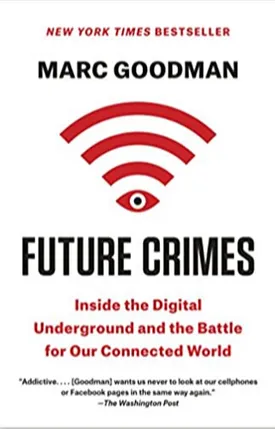Future Crimes: Inside the Digital Underground and the Battle for Our Connected World by Marc Goodman
In his book “Future Crimes: Inside the Digital Underground and the Battle for Our Connected World”, Marc Goodman takes a real close look at how cyber-crime is on the rise, and how our connected world remains vulnerable to attack. Goodman casts a wide net on the digital underground, detailing how criminals and hactivists abuse networks, steal identities, and take advantage of weak laws and regulations to commit various forms of fraud and blackmail. Along with this, he provides numerous examples of how “we,” as citizens of this highly connected world, can be easily victimized by cyber-criminals.
Goodman paints a vivid picture of the high-stakes field of cyberwarfare and online crime. It’s an alarming view of a world where cyber-thieves have the tools and the means to exploit our lack of cybersecurity challenges. Cyber-attacks can come from individuals, groups, and organized groups who are seeking financial gain, political power, or simply to disrupt normal life. But Goodman also offers hope. He outlines what steps each of us can take to protect ourselves while using the Internet, and he provides suggestions of how to rally the forces of law enforcement and private industry in the fight against cyber-crime.
Goodman explains why cyber-security must become an integral part of our lives. He looks at how a new era of digital anarchy has resulted in all the ways that technology can be abused. Starting with a brief history, he quickly coveres the creation of the first computer viruses, the rise of activity by organized cyber-criminals, and even the proliferation of cyber-weapons. He examines how hackers and even nation states use dark spaces of the Internet to commit digital crimes. Goodman also takes a comprehensive look at how digital fraud and identity theft wreak havoc on a personal and business level.
Goodman provides some practical advice on how to protect ourselves and our data from falling into the wrong hands. They include proactively using data to protect our personal information and device settings, using encryption to keep data safe, and being vigilant and proactive in order to recognize cyber-threats. He emphasizes that consumers must become their own “data sheriffs,” and he go further by calling on Congress and governments to pass new legislation that can help reinforce the policies and protocols used to secure our data.
In the end, Goodman provides an insightful assessment of the dynamic cyber-crime landscape and a powerful chronicle of the battle that everyday citizens continue to wage against this insidious form of criminal activity. He urges us to stay informed and to be mindful of the choices we make in how we interact with the digital world. Ultimately, he argues that we must shed the illusion that the digital world can be completely safe, but showing readers the steps they can take to secure our data and devices. “Future Crimes” provides a necessary and timely primer on the ever-changing threats posed by cyber-crime. For anyone interested in understanding its underlying causes and symptoms, as well as what we can do to protect ourselves, this book is essential reading.

